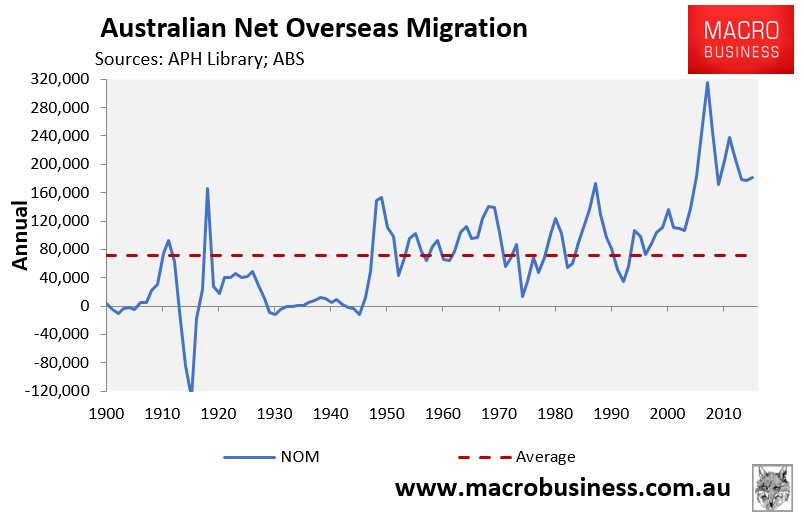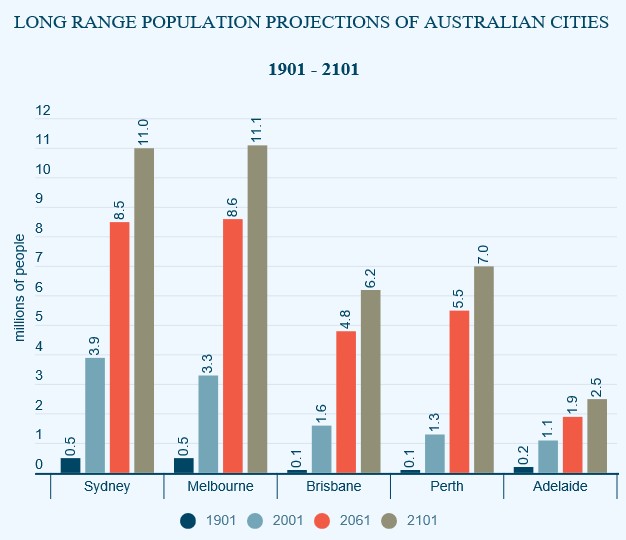KPMG’s Bernard Salt – the self-proclaimed “unabashed supporter of a bigger Australia” – has penned another piece in The Australian spruiking mass immigration and claiming that the march toward ‘mega-cities’ will drive the nation’s productivity:
There will be more growth in Australia’s biggest cities over the next 30 years than in the biggest cities of the developed world.
In fact it is hard to identify any developed-world city that is projected to record a higher percentage increase in population than Perth, Brisbane, Melbourne and Sydney by mid-century.
The reason of course is the controversial policy of Big Australia, which lifted net overseas migration from around 100,000 per year to 180,000 per year. That transformation took place about a decade ago and, despite a few ups and downs, has remained in place ever since.
With more people coming into Australia, our biggest cities are tracking higher rates of growth…
Sydney and Melbourne are officially expected to accommodate another three million residents by the mid-2050s; southeast Queensland and Perth are expected to add another two million each. These numbers translate into net growth of between 56 per cent for Sydney and 127 per cent for Perth over this period…
The single most important issue in city planning and visioning in Australia is addressing the logic of why our cities need to grow so far and so fast…
The reasoning behind Australia’s elevated levels of migration are varied. It is partially driven by the ageing of the baby boomers exiting the workforce, creating a labour vacuum that must be filled by younger workers…
It is also partially a risk-mitigation strategy, a demonstration of good faith, by the Australian people that we are prepared to share the bounty of this land with all races and creeds for generations…
And there is the logic that some level of population growth supports economic prosperity.
In June last year, Bernard Salt published population forecasts, which projected that the populations of Sydney and Melbourne could climb to 11 million by the end of the century:
Anyone living in the big cities should find these population projections truly horrifying. Sydney and Melbourne are already straining under 12 years of rampant population growth (immigration) and are ceasing to function properly. So, imagine how badly they would operate in the event that they roughly tripled in size. They would become a nightmare to live in.
Bernard Salt’s reasons why Australia should pursue a ‘Big Australia’ mass immigration program are also laughable.
Salt’s claim that “the ageing of the baby boomers” will create “a labour vacuum that must be filled by younger workers” is wrong on several counts.
Back in 2015, Salt warned that technological change will mean there are likely to be too few jobs to go around in the future:
What if by 2030 we don’t need 12 million workers; we needed only nine million? In such a world work retreats to knowledge enclaves such as Silicon Valley or to the privileged infrastructure-rich centres of Australia’s biggest cities.
How do we organise a society in which not everyone works yet where the number in the prime of their lives continues to expand?..
The question here and in the US will be the political ramifications from the development of a society where work and work-based remuneration may well be a scarce resource amid an expanding working-age population.
And last year, Salt estimated that up to half of Australian jobs could be at risk from digitisation, and again warned that technological change could mean there will too few jobs to go around.
Given that Salt believes that there could be too few jobs to go around in the future, why does he support mass immigration on spurious labour shortage grounds?
In any event, the Productivity Commission (PC) has comprehensively debunked the claim that immigration is required to prevent the population from ageing. Here’s a selection of quotes from the PC over the past decade:
- PC (2005): “Despite popular thinking to the contrary, immigration policy is also not a feasible countermeasure [to an ageing population]. It affects population numbers more than the age structure”.
- PC (2010): “Realistic changes in migration levels also make little difference to the age structure of the population in the future, with any effect being temporary“…
- PC (2011): “…substantial increases in the level of net overseas migration would have only modest effects on population ageing and the impacts would be temporary, since immigrants themselves age… It follows that, rather than seeking to mitigate the ageing of the population, policy should seek to influence the potential economic and other impacts”…
- PC (2016): “[Immigration] delays rather than eliminates population ageing. In the long term, underlying trends in life expectancy mean that permanent immigrants (as they age) will themselves add to the proportion of the population aged 65 and over”.
In short, trying to overcome an ageing population through higher immigration is a Ponzi scheme. It requires ever more immigration, with the associated negative impacts on economic and social infrastructure, congestion, housing affordability, and the environment.
Salt’s claim that Australia must continue pursue a ‘Big Australia’ as “a demonstration of good faith” is a weak argument. Why does Australia’s immigration intake need to be so much greater than historical norms and so far above other nations?

And what about the interests of incumbent residents? Isn’t it the government’s number one job to look after them first and foremost?
This brings me to Salt’s final reason for mass immigration: that it “supports economic prosperity”. This is curious, because the PC’s own modelling has found that existing workers are made worse-off via immigration. Why? Because they experience lower wages growth than would otherwise be the case, in addition to suffering from greater traffic congestion, smaller and more expensive housing, as well as reduced overall amenity.
Salt conveniently left out the most enduring reason for mass immigration: that it supports his big business pay masters and allows them to generate lazy profits via an ever-growing base of consumers and debt. Immigration is a way to privatise the benefits from growth to the elite few while the costs are borne by everyone else.


